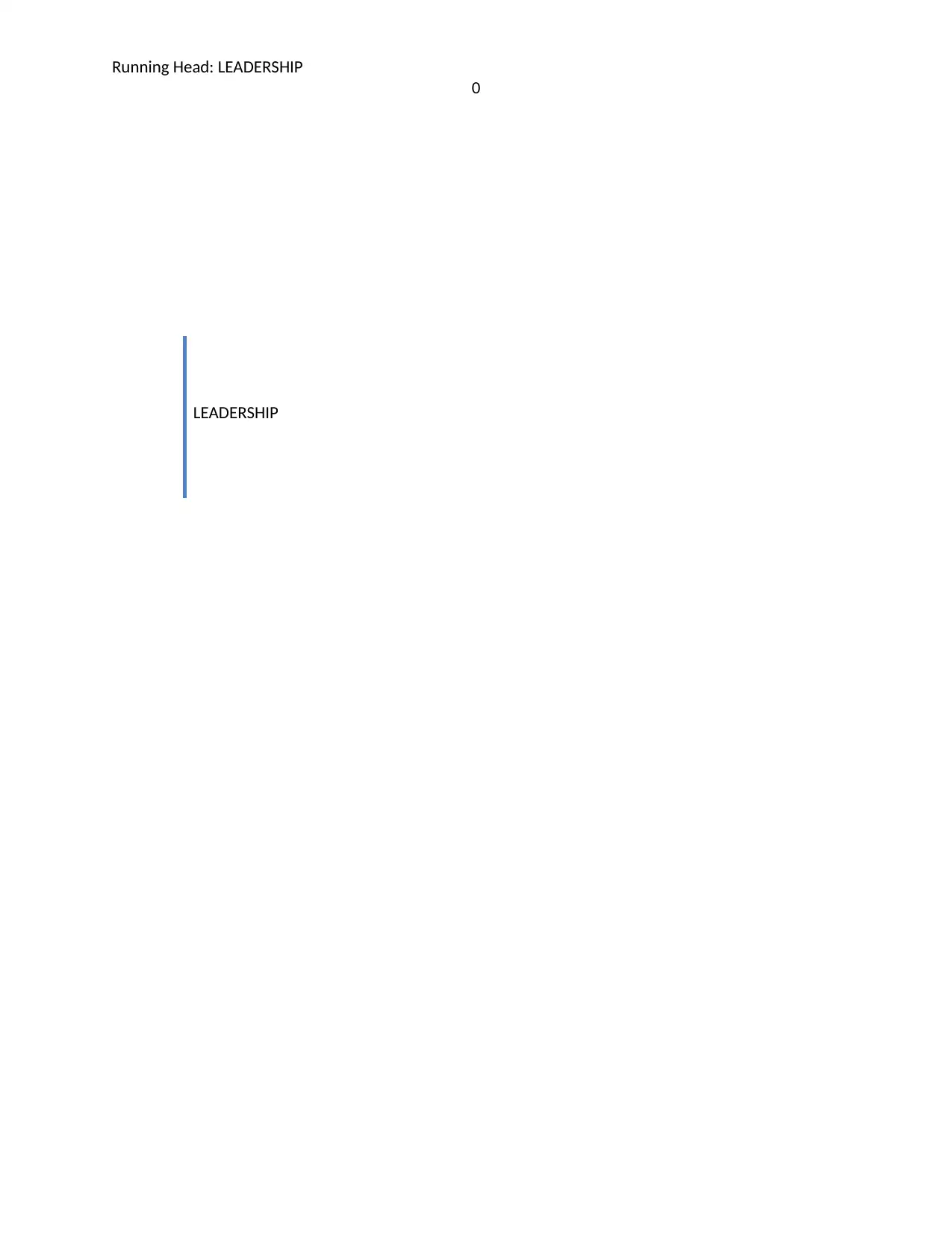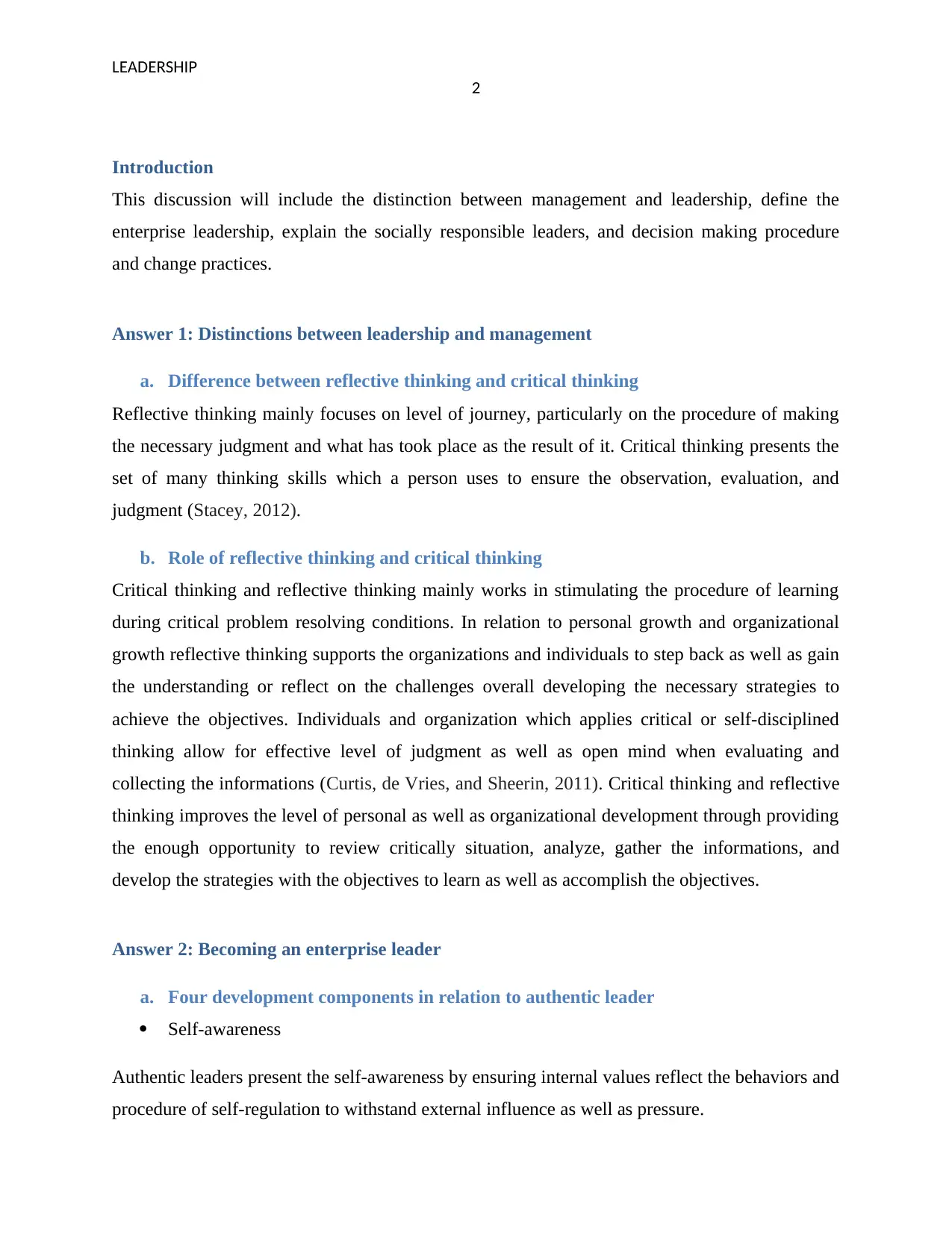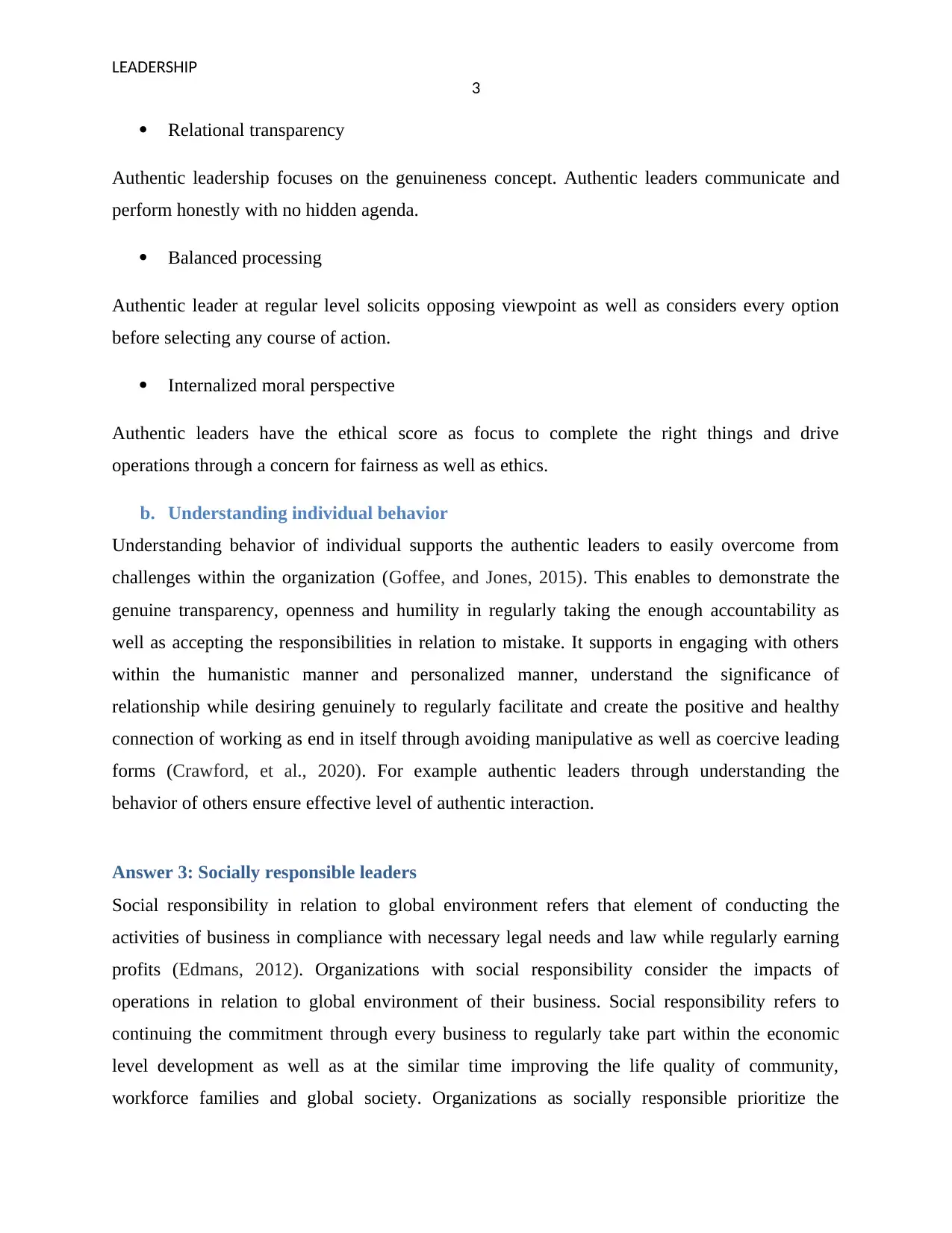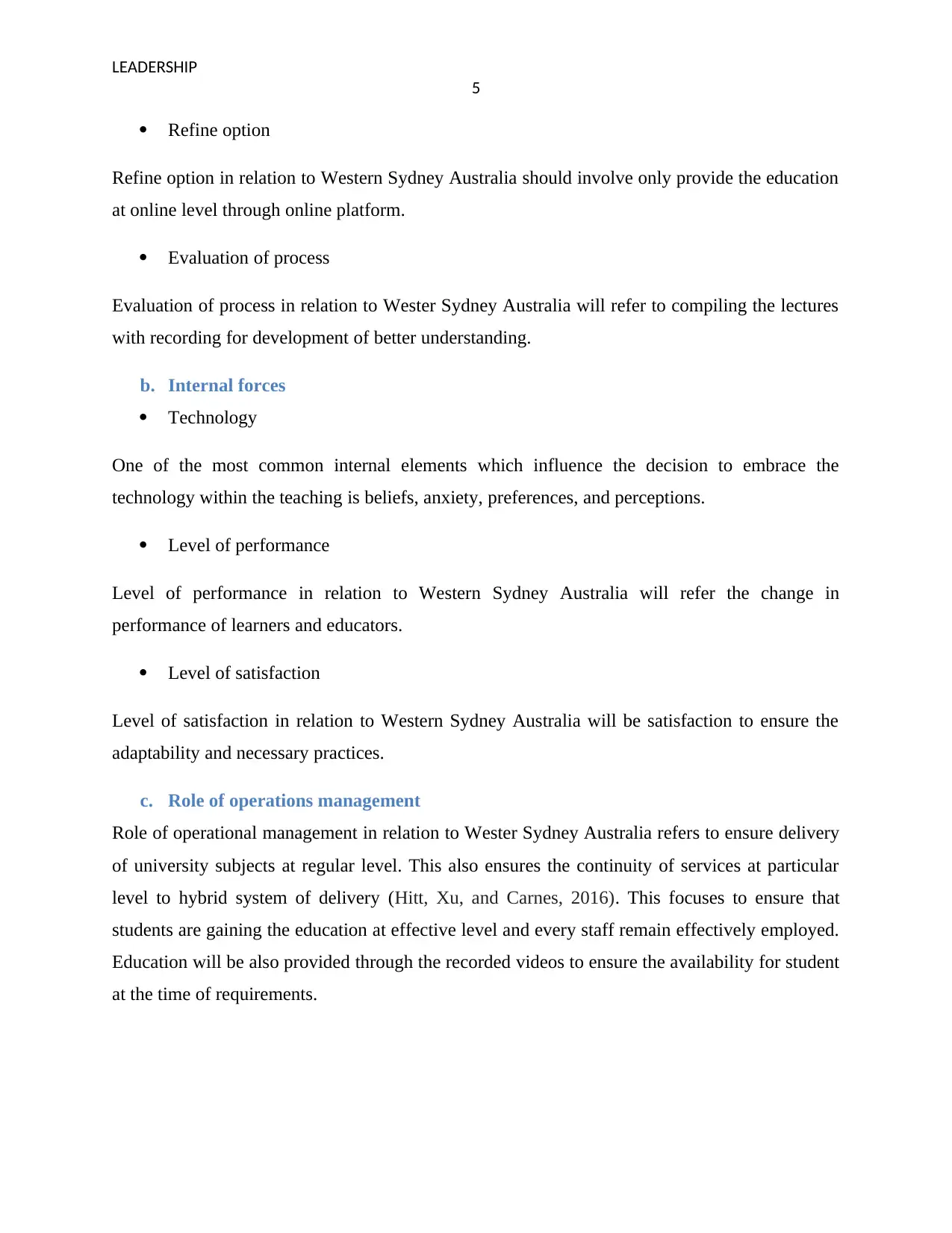Leadership and Management Report: Analysis and Discussion
VerifiedAdded on 2022/08/17
|8
|1434
|14
Report
AI Summary
This report provides a comprehensive analysis of leadership and management, exploring the distinctions between the two concepts. It delves into reflective and critical thinking, highlighting their roles in problem-solving and organizational development. The report defines enterprise leadership, outlining its core components, including self-awareness, relational transparency, balanced processing, and internalized moral perspective. It also examines the significance of understanding individual behavior for authentic leaders. Furthermore, the report discusses socially responsible leadership, emphasizing the importance of ethical, economic, and legal responsibilities in a global context. It then presents a six-step decision-making process, illustrating its application through a case study. The report also explores internal forces such as technology, performance, and satisfaction, and their impact on decision-making. Finally, it examines the role of operations management in ensuring service continuity and effective education delivery.

Running Head: LEADERSHIP
0
LEADERSHIP
0
LEADERSHIP
Paraphrase This Document
Need a fresh take? Get an instant paraphrase of this document with our AI Paraphraser

LEADERSHIP
1
Table of Contents
Introduction......................................................................................................................................2
Answer 1: Distinctions between leadership and management........................................................2
a. Difference between reflective thinking and critical thinking...............................................2
b. Role of reflective thinking and critical thinking...................................................................2
Answer 2: Becoming an enterprise leader.......................................................................................2
a. Four development components in relation to authentic leader.............................................2
b. Understanding individual behavior.......................................................................................3
Answer 3: Socially responsible leaders...........................................................................................3
Answer 4:.........................................................................................................................................4
a. Six step decision making process.........................................................................................4
b. Internal forces.......................................................................................................................5
c. Role of operations management...........................................................................................5
Conclusion.......................................................................................................................................6
References........................................................................................................................................7
1
Table of Contents
Introduction......................................................................................................................................2
Answer 1: Distinctions between leadership and management........................................................2
a. Difference between reflective thinking and critical thinking...............................................2
b. Role of reflective thinking and critical thinking...................................................................2
Answer 2: Becoming an enterprise leader.......................................................................................2
a. Four development components in relation to authentic leader.............................................2
b. Understanding individual behavior.......................................................................................3
Answer 3: Socially responsible leaders...........................................................................................3
Answer 4:.........................................................................................................................................4
a. Six step decision making process.........................................................................................4
b. Internal forces.......................................................................................................................5
c. Role of operations management...........................................................................................5
Conclusion.......................................................................................................................................6
References........................................................................................................................................7

LEADERSHIP
2
Introduction
This discussion will include the distinction between management and leadership, define the
enterprise leadership, explain the socially responsible leaders, and decision making procedure
and change practices.
Answer 1: Distinctions between leadership and management
a. Difference between reflective thinking and critical thinking
Reflective thinking mainly focuses on level of journey, particularly on the procedure of making
the necessary judgment and what has took place as the result of it. Critical thinking presents the
set of many thinking skills which a person uses to ensure the observation, evaluation, and
judgment (Stacey, 2012).
b. Role of reflective thinking and critical thinking
Critical thinking and reflective thinking mainly works in stimulating the procedure of learning
during critical problem resolving conditions. In relation to personal growth and organizational
growth reflective thinking supports the organizations and individuals to step back as well as gain
the understanding or reflect on the challenges overall developing the necessary strategies to
achieve the objectives. Individuals and organization which applies critical or self-disciplined
thinking allow for effective level of judgment as well as open mind when evaluating and
collecting the informations (Curtis, de Vries, and Sheerin, 2011). Critical thinking and reflective
thinking improves the level of personal as well as organizational development through providing
the enough opportunity to review critically situation, analyze, gather the informations, and
develop the strategies with the objectives to learn as well as accomplish the objectives.
Answer 2: Becoming an enterprise leader
a. Four development components in relation to authentic leader
Self-awareness
Authentic leaders present the self-awareness by ensuring internal values reflect the behaviors and
procedure of self-regulation to withstand external influence as well as pressure.
2
Introduction
This discussion will include the distinction between management and leadership, define the
enterprise leadership, explain the socially responsible leaders, and decision making procedure
and change practices.
Answer 1: Distinctions between leadership and management
a. Difference between reflective thinking and critical thinking
Reflective thinking mainly focuses on level of journey, particularly on the procedure of making
the necessary judgment and what has took place as the result of it. Critical thinking presents the
set of many thinking skills which a person uses to ensure the observation, evaluation, and
judgment (Stacey, 2012).
b. Role of reflective thinking and critical thinking
Critical thinking and reflective thinking mainly works in stimulating the procedure of learning
during critical problem resolving conditions. In relation to personal growth and organizational
growth reflective thinking supports the organizations and individuals to step back as well as gain
the understanding or reflect on the challenges overall developing the necessary strategies to
achieve the objectives. Individuals and organization which applies critical or self-disciplined
thinking allow for effective level of judgment as well as open mind when evaluating and
collecting the informations (Curtis, de Vries, and Sheerin, 2011). Critical thinking and reflective
thinking improves the level of personal as well as organizational development through providing
the enough opportunity to review critically situation, analyze, gather the informations, and
develop the strategies with the objectives to learn as well as accomplish the objectives.
Answer 2: Becoming an enterprise leader
a. Four development components in relation to authentic leader
Self-awareness
Authentic leaders present the self-awareness by ensuring internal values reflect the behaviors and
procedure of self-regulation to withstand external influence as well as pressure.
⊘ This is a preview!⊘
Do you want full access?
Subscribe today to unlock all pages.

Trusted by 1+ million students worldwide

LEADERSHIP
3
Relational transparency
Authentic leadership focuses on the genuineness concept. Authentic leaders communicate and
perform honestly with no hidden agenda.
Balanced processing
Authentic leader at regular level solicits opposing viewpoint as well as considers every option
before selecting any course of action.
Internalized moral perspective
Authentic leaders have the ethical score as focus to complete the right things and drive
operations through a concern for fairness as well as ethics.
b. Understanding individual behavior
Understanding behavior of individual supports the authentic leaders to easily overcome from
challenges within the organization (Goffee, and Jones, 2015). This enables to demonstrate the
genuine transparency, openness and humility in regularly taking the enough accountability as
well as accepting the responsibilities in relation to mistake. It supports in engaging with others
within the humanistic manner and personalized manner, understand the significance of
relationship while desiring genuinely to regularly facilitate and create the positive and healthy
connection of working as end in itself through avoiding manipulative as well as coercive leading
forms (Crawford, et al., 2020). For example authentic leaders through understanding the
behavior of others ensure effective level of authentic interaction.
Answer 3: Socially responsible leaders
Social responsibility in relation to global environment refers that element of conducting the
activities of business in compliance with necessary legal needs and law while regularly earning
profits (Edmans, 2012). Organizations with social responsibility consider the impacts of
operations in relation to global environment of their business. Social responsibility refers to
continuing the commitment through every business to regularly take part within the economic
level development as well as at the similar time improving the life quality of community,
workforce families and global society. Organizations as socially responsible prioritize the
3
Relational transparency
Authentic leadership focuses on the genuineness concept. Authentic leaders communicate and
perform honestly with no hidden agenda.
Balanced processing
Authentic leader at regular level solicits opposing viewpoint as well as considers every option
before selecting any course of action.
Internalized moral perspective
Authentic leaders have the ethical score as focus to complete the right things and drive
operations through a concern for fairness as well as ethics.
b. Understanding individual behavior
Understanding behavior of individual supports the authentic leaders to easily overcome from
challenges within the organization (Goffee, and Jones, 2015). This enables to demonstrate the
genuine transparency, openness and humility in regularly taking the enough accountability as
well as accepting the responsibilities in relation to mistake. It supports in engaging with others
within the humanistic manner and personalized manner, understand the significance of
relationship while desiring genuinely to regularly facilitate and create the positive and healthy
connection of working as end in itself through avoiding manipulative as well as coercive leading
forms (Crawford, et al., 2020). For example authentic leaders through understanding the
behavior of others ensure effective level of authentic interaction.
Answer 3: Socially responsible leaders
Social responsibility in relation to global environment refers that element of conducting the
activities of business in compliance with necessary legal needs and law while regularly earning
profits (Edmans, 2012). Organizations with social responsibility consider the impacts of
operations in relation to global environment of their business. Social responsibility refers to
continuing the commitment through every business to regularly take part within the economic
level development as well as at the similar time improving the life quality of community,
workforce families and global society. Organizations as socially responsible prioritize the
Paraphrase This Document
Need a fresh take? Get an instant paraphrase of this document with our AI Paraphraser

LEADERSHIP
4
internal challenges such as treatment of females and minorities within the organization and
regularly maintaining the appropriate level of employee’s relationship by effective level of
compensation to employee and leadership.
In today’s competitive business environment employees have the ethical responsibility,
economic responsibility, and legal responsibility to mind the all treatment in relation to
environment external perception about the quality level as well as compensation to employees
regarding the sake of internal market comparisons. In today’s global environment organizations
which take the initiative to regular voluntary take into the many considerations impact of
operations on global level environment of business. Businesses with social responsibility make
the all decisions to ensure the improvement in quality level of life and sustainable development
concept (Dorling, 2012).
Answer 4:
a. Six step decision making process
Explanation of desired activities and outcomes
Desire activity in relation to Western Sydney University should refer to education involve
movement of teaching at online level to ensure continuity of education.
Endorse the process
Procedure in relation to Western Sydney Australia will refer to move level of teaching from
online delivery only to the hybrid delivery system.
Development of criteria
Educators should focus to provide the 50% of classes at online level by online platform and 50%
face to face in class.
Development of options
Development of option should involve the plan to improve level of decision making, change,
innovation, and operations.
4
internal challenges such as treatment of females and minorities within the organization and
regularly maintaining the appropriate level of employee’s relationship by effective level of
compensation to employee and leadership.
In today’s competitive business environment employees have the ethical responsibility,
economic responsibility, and legal responsibility to mind the all treatment in relation to
environment external perception about the quality level as well as compensation to employees
regarding the sake of internal market comparisons. In today’s global environment organizations
which take the initiative to regular voluntary take into the many considerations impact of
operations on global level environment of business. Businesses with social responsibility make
the all decisions to ensure the improvement in quality level of life and sustainable development
concept (Dorling, 2012).
Answer 4:
a. Six step decision making process
Explanation of desired activities and outcomes
Desire activity in relation to Western Sydney University should refer to education involve
movement of teaching at online level to ensure continuity of education.
Endorse the process
Procedure in relation to Western Sydney Australia will refer to move level of teaching from
online delivery only to the hybrid delivery system.
Development of criteria
Educators should focus to provide the 50% of classes at online level by online platform and 50%
face to face in class.
Development of options
Development of option should involve the plan to improve level of decision making, change,
innovation, and operations.

LEADERSHIP
5
Refine option
Refine option in relation to Western Sydney Australia should involve only provide the education
at online level through online platform.
Evaluation of process
Evaluation of process in relation to Wester Sydney Australia will refer to compiling the lectures
with recording for development of better understanding.
b. Internal forces
Technology
One of the most common internal elements which influence the decision to embrace the
technology within the teaching is beliefs, anxiety, preferences, and perceptions.
Level of performance
Level of performance in relation to Western Sydney Australia will refer the change in
performance of learners and educators.
Level of satisfaction
Level of satisfaction in relation to Western Sydney Australia will be satisfaction to ensure the
adaptability and necessary practices.
c. Role of operations management
Role of operational management in relation to Wester Sydney Australia refers to ensure delivery
of university subjects at regular level. This also ensures the continuity of services at particular
level to hybrid system of delivery (Hitt, Xu, and Carnes, 2016). This focuses to ensure that
students are gaining the education at effective level and every staff remain effectively employed.
Education will be also provided through the recorded videos to ensure the availability for student
at the time of requirements.
5
Refine option
Refine option in relation to Western Sydney Australia should involve only provide the education
at online level through online platform.
Evaluation of process
Evaluation of process in relation to Wester Sydney Australia will refer to compiling the lectures
with recording for development of better understanding.
b. Internal forces
Technology
One of the most common internal elements which influence the decision to embrace the
technology within the teaching is beliefs, anxiety, preferences, and perceptions.
Level of performance
Level of performance in relation to Western Sydney Australia will refer the change in
performance of learners and educators.
Level of satisfaction
Level of satisfaction in relation to Western Sydney Australia will be satisfaction to ensure the
adaptability and necessary practices.
c. Role of operations management
Role of operational management in relation to Wester Sydney Australia refers to ensure delivery
of university subjects at regular level. This also ensures the continuity of services at particular
level to hybrid system of delivery (Hitt, Xu, and Carnes, 2016). This focuses to ensure that
students are gaining the education at effective level and every staff remain effectively employed.
Education will be also provided through the recorded videos to ensure the availability for student
at the time of requirements.
⊘ This is a preview!⊘
Do you want full access?
Subscribe today to unlock all pages.

Trusted by 1+ million students worldwide

LEADERSHIP
6
Conclusion
The discussion has explained about the organizational leadership as per the requirement of many
scenarios. It has included them through utilizing the many scenarios and examples to present
with effectiveness.
6
Conclusion
The discussion has explained about the organizational leadership as per the requirement of many
scenarios. It has included them through utilizing the many scenarios and examples to present
with effectiveness.
Paraphrase This Document
Need a fresh take? Get an instant paraphrase of this document with our AI Paraphraser

LEADERSHIP
7
References
Stacey, R., 2012. Tools and techniques of leadership and management: Meeting the challenge of
complexity. Routledge.
Curtis, E.A., de Vries, J. and Sheerin, F.K., 2011. Developing leadership in nursing: exploring
core factors. British Journal of Nursing, 20(5), pp.306-309.
Goffee, R. and Jones, G., 2015. Why should anyone be led by You? With a new preface by the
Authors: What it takes to be an authentic leader. Harvard Business Review Press.
Crawford, J.A., Dawkins, S., Martin, A. and Lewis, G., 2020. Putting the leader back into
authentic leadership: Reconceptualising and rethinking leaders. Australian Journal of
Management, 45(1), pp.114-133.
Edmans, A. (2012). The link between job satisfaction and firm value, with implications for
corporate social responsibility. Academy of Management Perspectives, 26(4), 1-19.
Dorling, D. (2012). The visualization of spatial social structure. John Wiley & Sons.
Hitt, M.A., Xu, K. and Carnes, C.M., 2016. Resource based theory in operations management
research. Journal of Operations Management, 41, pp.77-94.
7
References
Stacey, R., 2012. Tools and techniques of leadership and management: Meeting the challenge of
complexity. Routledge.
Curtis, E.A., de Vries, J. and Sheerin, F.K., 2011. Developing leadership in nursing: exploring
core factors. British Journal of Nursing, 20(5), pp.306-309.
Goffee, R. and Jones, G., 2015. Why should anyone be led by You? With a new preface by the
Authors: What it takes to be an authentic leader. Harvard Business Review Press.
Crawford, J.A., Dawkins, S., Martin, A. and Lewis, G., 2020. Putting the leader back into
authentic leadership: Reconceptualising and rethinking leaders. Australian Journal of
Management, 45(1), pp.114-133.
Edmans, A. (2012). The link between job satisfaction and firm value, with implications for
corporate social responsibility. Academy of Management Perspectives, 26(4), 1-19.
Dorling, D. (2012). The visualization of spatial social structure. John Wiley & Sons.
Hitt, M.A., Xu, K. and Carnes, C.M., 2016. Resource based theory in operations management
research. Journal of Operations Management, 41, pp.77-94.
1 out of 8
Related Documents
Your All-in-One AI-Powered Toolkit for Academic Success.
+13062052269
info@desklib.com
Available 24*7 on WhatsApp / Email
![[object Object]](/_next/static/media/star-bottom.7253800d.svg)
Unlock your academic potential
Copyright © 2020–2025 A2Z Services. All Rights Reserved. Developed and managed by ZUCOL.




